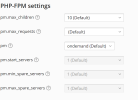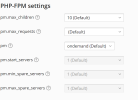- Server operating system version
- Ubuntu 20.04.4 LTS
- Plesk version and microupdate number
- Version 18.0.44
Hello,
I recently switched one of our servers from WHM on CENTos7 to a brand new Ubuntu 20.04 :
Ubuntu 20.04.4 LTS
Plesk Obsidian
Version 18.0.44 Update #3
We use this server for as a Wordpress preproduction environnement, and as soon as I switched, i realized that the thumbnail regeneration was very slow on the new machine.
On the same website, on the old server (8 cores of an old 2012 Xenon), the regenaration happens on all cores and takes around 6 minutes to complete. On the new one, it happens on only one core (2021 12 cores Xenon), and it takes around 35 minutes to complete !
i'm mainly using PHP 8.0.20 FPM application, but i tried several settings ranging from PHP7 fastCGI, dedicated FPM... it always uses only one core.
Tried several other things regarding PHP and Apache (event, prefork...) but I cannot find how to solve this issue.
I'm running another Plesk Obsidian server on ubuntu 18.04 and i'm not having this issue.
What did I miss ? Is this a kernel issue ?
Any help appreciated.
I recently switched one of our servers from WHM on CENTos7 to a brand new Ubuntu 20.04 :
Ubuntu 20.04.4 LTS
Plesk Obsidian
Version 18.0.44 Update #3
We use this server for as a Wordpress preproduction environnement, and as soon as I switched, i realized that the thumbnail regeneration was very slow on the new machine.
On the same website, on the old server (8 cores of an old 2012 Xenon), the regenaration happens on all cores and takes around 6 minutes to complete. On the new one, it happens on only one core (2021 12 cores Xenon), and it takes around 35 minutes to complete !
i'm mainly using PHP 8.0.20 FPM application, but i tried several settings ranging from PHP7 fastCGI, dedicated FPM... it always uses only one core.
Tried several other things regarding PHP and Apache (event, prefork...) but I cannot find how to solve this issue.
I'm running another Plesk Obsidian server on ubuntu 18.04 and i'm not having this issue.
What did I miss ? Is this a kernel issue ?
Any help appreciated.



